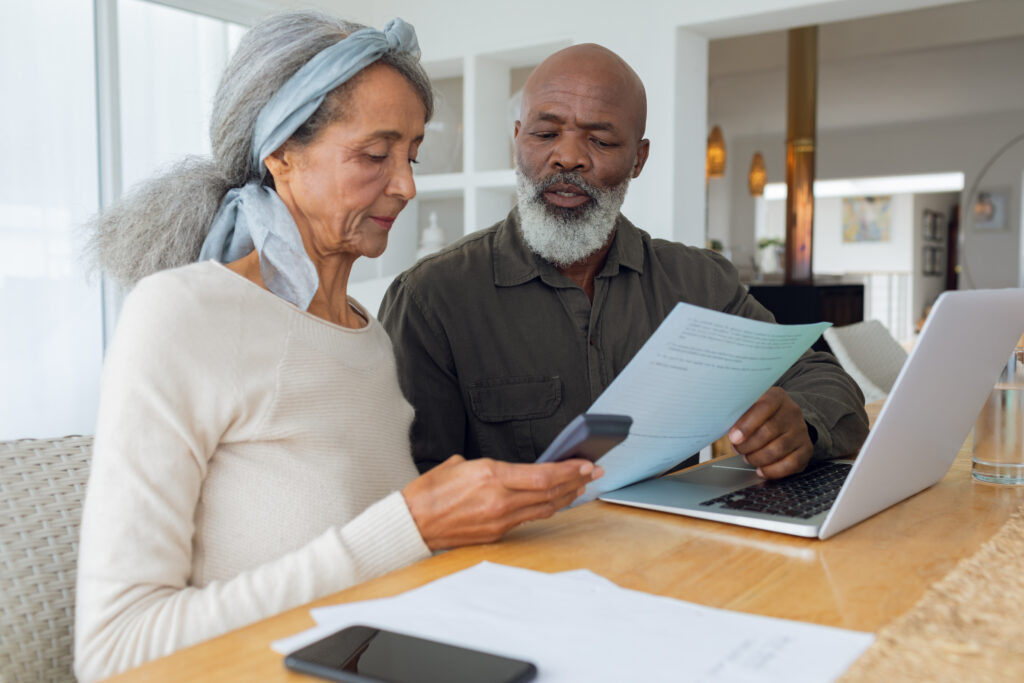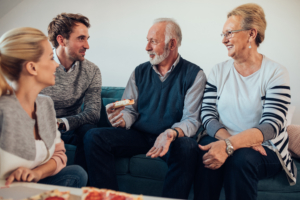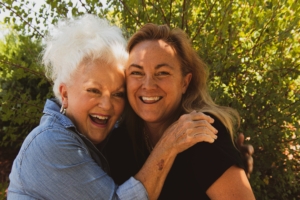Aging in place is a top 3 trend in senior care this year. In recent years as a result of the pandemic and access to healthcare industry has seen a significant transformation, fueled in large part by the advancements of telehealth services or the Telehealth Revolution. Telehealth has become a tool to help our seniors continue to age in place.
For seniors, caregivers, and healthcare professionals, this shift towards remote care is not just a matter of convenience; it’s a lifeline that supports the growing desire to age in place. It also helps to ensure access to care. At Your Nurse Advocate Consulting, we’ve seen firsthand the positive outcomes that come from integrating telehealth into the care continuum for aging adults.

In a time where technological advancements are drastically transforming lives, telehealth services emerge as a beacon of hope for seniors striving to age comfortably and independently in their own homes. When the telehealth revolution was born out of the pandemic, we were skeptical. As both practicing nurses for over 40 years, Linda and I doubted the effectiveness of telehealth provider visits.
How can you examine a patient without touching them, listening to their lungs, feeling their abdomen. How was this going to work? There are now blue tooth stethoscopes, and other sophisticated tools that allow providers to do what they do best, examine a patient. All you need is a “Smart” cell phone, and you don’t even need to be on a computer anymore.
My personal experience with my mother-in-law raised my doubts even further. It was the month following complete shut down with the pandemic. I had noticed a lump under her chin and wasn’t sure if she had a swollen lymph gland. She had not been ill. I was worried about all the things this might be so we made a doctor appointment. The provider came in with a full hazmat suit, hood, gloves, the whole works.
We explained the concern and the provider never touched her. Never even felt the lump. The provider maintained a “safe” distance. The provider told us we should wait a bit and see what happens. Watch it to see if it gets worse or better over the next couple of weeks. I gladly put my advocate cap on and said, “Nope, we are doing something right now. How about an ultrasound of the lump and try to figure out what it is.” The provider agreed and an ultrasound was completed.
Next thing we know the radiologist suggested a biopsy. We said can we do it right now? He said yes and we moved forward to get that done as well. It turned out she had Non-Hodgkins Lymphoma, Stage 4, a type of blood cancer and she needed to see oncology ASAP.
As we continue to share our thoughts and information on Telehealth, we admit it has come a long way and we hope to share with you that it can be a valuable tool to address some of the concerns that aging in place raises. We will also include an eye-opening interview from our Senior Care Summit Series with Dr. James Williams, MD. His practice is now all telehealth and how he makes it work and feels very strongly this is a great aide to your aging adults.

The Comfort of Care at Home
One of the biggest benefits of telehealth for seniors is the ability to access medical care without leaving the comfort of their homes. This aspect of remote care cannot be overstated – it’s about more than just convenience; it’s about safety, independence, and the warmth of familiarity. For many seniors, particularly those with mobility issues or chronic conditions, the physical act of visiting a doctor can be exhausting and even daunting.
Living in a rural area where medical transportation or even a lack of cab service or “uber” can impede our aging adults from getting to the doctor’s office independently. This often means missed work for a caregiver or family member.
The Comfort of Care at Home
The primary allure of telehealth services lies in the ability of seniors to access medical care without the need to leave their comforts of home. This innovation is not just about comfort; it’s about preserving dignity and promoting independence among our elderly population.
Dr. James Williams, whose practice has transitioned to being entirely remote, highlights how this model allows him to effectively reach patients in their homes, nursing facilities, or assisted living spaces. This flexibility is crucial for those whose mobility becomes more limited with age.
Real-Life Impact
Dr. James Williams shared insights into the real-life impact of telehealth on aging in place. Through his telehealth practice, Dr. Williams has been able to reach out to patients who would otherwise be isolated due to their physical conditions or geographical location. His experiences highlight the profound potential of remote care in improving the quality of life for aging adults, allowing them to stay in their homes while receiving the medical attention they need.
Chronic Condition Management Made Easier
Tele-monitoring for chronic disease has been around for quite awhile already. One of the more popular ones is the Congestive Heart Failure home monitoring program that many hospital systems have. Patients can wear portable cardiac monitors, have sleep apnea tests done at home, Chronic Obstructive Pulmonary Disease, asthma, diabetes, and even some neurological diseases such as Parkinson’s Disease, M.S. or even Dementia can be monitored from home. We are sure we may be missing some as well!
Frequent hospital visits can be taxing and, quite frankly, unnecessary for routine monitoring of chronic conditions. Telehealth provides a streamlined solution, offering the capability for regular check-ups and early detection of potential health concerns from afar. This not only reduces the physical strain on seniors but also plays a significant role in preventing medical emergencies, thus ensuring that aging individuals remain safe in their preferred environments.
Breaking Down Geographical Barriers
The reach of telehealth eliminates geographical limitations, ensuring seniors have access to the best specialists, regardless of where they are located. This is particularly crucial in rural areas, where specialist care may not be readily available. Oftentimes the wait list to see a specialist may be 3 months or more.
The ability to consult with a healthcare professional from hundreds of miles away means that aging adults can receive comprehensive care without the stress and risk of long-distance travel, and it may allow you to have an appointment with a specialist sooner than later. This ensures that comprehensive care is more than just an ideal; it’s a reality.
Isolation and mental health challenges are significant concerns for seniors. Telehealth services are proving to be vital in providing support through remote counseling and therapy sessions. This accessibility to mental health professionals can make a world of difference in the lives of seniors, offering them a way to share their concerns and receive the help they need to maintain their emotional and psychological well-being.

By dizain Adobe Stock Photos
Addressing Mental Health in the Comfort of Home
Many aging adults are from a generation that believed seeing someone for a mental health concern came with a stigma. They did not want to be “diagnosed” with a mental health disorder for reasons of embarrassment. We have seniors not receiving optimal care because they needed to see behavioral health as their primary care provider was not comfortable adjusting or regulating certain “psychiatric” medications. They ended up going with a standard medication that may not be optimal for their particular condition but the provider felt “comfortable prescribing this one.”
Isolation and the mental health challenges that accompany aging are significant issues. Telehealth services counter these challenges by providing remote counseling and therapy sessions, offering a lifeline to those feeling disconnected. The privacy and comfort of receiving mental health support at home can encourage more seniors to seek help, fostering a healthier, more supportive environment for aging in place. It can help reduce the “stigma” effect.
Enhanced Communication for Personalized Care
Perhaps one of the most significant benefits of telehealth is how it enhances communication and coordination among seniors, caregivers, and healthcare providers. This collaborative approach leads to more personalized and effective care, with all parties staying informed and engaged in the decision-making process.
An added layer of support is a patient or health advocate to help ensure the types of things we have mentioned so far are addressed and your aging loved one is getting the best care possible. As nurse patient advocates, we can help navigate the healthcare system while making sure all the questions get asked and addressed by the healthcare providers. We can help you put plans in place to make sure we are meeting all the healthcare goals including aging in place for your aging parent or loved one.
Strengthening Communication Between All Parties Involved
A notable benefit of telehealth is the enhanced communication and coordination it facilitates between seniors, caregivers, and healthcare providers. This digitized approach leads to more personalized, effective care, tailored to the unique needs of each individual. Regular telehealth interactions build a stronger, more informed care network around each senior, ensuring their well-being is always a priority. Having access to your aging loved one’s “My Chart” or online patient portal with their clinic or hospital system is an easy way to stay on top of their health and well-being. It is a great way to stay informed in real-time.

The Future Is Here
Telehealth for Seniors, Aging in Place, Remote Care for Elderly
The telehealth revolution is not coming; it’s already here. These are not just buzzwords or trends; they represent a movement towards a future where aging in place is supported by innovative, accessible healthcare solutions. Telehealth services are paving the way for a world where seniors can enjoy the golden years of their lives in the comfort and familiarity of their own homes, with the assurance that quality medical care is just a call away. By the year 2030 all baby boomers will be age 65 or older. We have to develop systems that care for all the health challenges that arise in older age individuals.
With the shortage of care workers as the population ages we may not have as many beds available in assisted living or nursing home levels of care. Aging in place may become a necessity for some vs a choice.
For seniors, the opportunities presented by remote care services are immeasurable. It is fostering independence, enhancing quality of care, and fundamentally changing the way we think about aging and healthcare.
Share Your Telehealth Experience with Us
Telehealth is not just a passing trend; it’s a revolution in healthcare, redefining what it means to age in place. With each passing day, it becomes clearer that the future of elderly care lies in the hands of technology—technology that brings healthcare home.
We’re inspired by the stories of those who have embraced telehealth to support aging in place, and we want to hear from you. Share Your Telehealth Experience with Us. Whether you’re a senior, caregiver, or healthcare professional, your insights can help shine a light on the benefits and challenges of telehealth and how it’s shaping the future of senior care.
Telehealth for seniors, remote care for the elderly, and aging in place are more than just concepts – they’re realities that are improving lives every day. Join us in exploring and advocating for the continuation and expansion of telehealth services. Together, we can ensure that every senior has the opportunity to age gracefully and comfortably in the place they call home.
Thanks for stopping by and spending some time with us. We hope you have walked away with a couple of nuggets you can use to better the health of an aging loved one. Please reach out with questions or concerns and we are happy to help!
See the resource section below for some of our free resources.
Take care and see you back here soon,
Pam and Linda
Your Nurse Advocates
Resource Section
https://yournurseadvocate.yournurseadvocateconsulting.com/10-steps-you-must-know.html
https://www.nia.nih.gov/health/caregiving/services-older-adults-living-home






